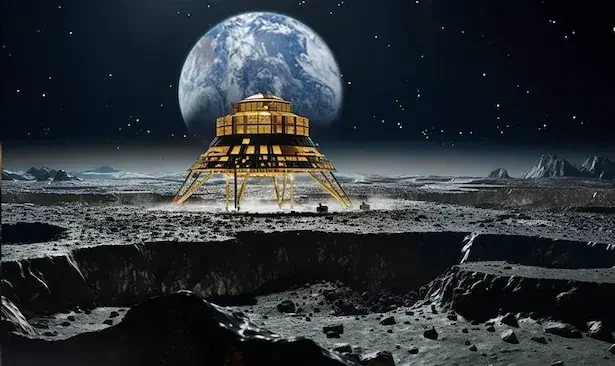Russia and China’s lunar nuclear plant: Russian and Chinese engineers may soon collaborate to build a nuclear power plant on the moon, as Russia explores new energy solutions beyond Earth’s borders. This ambitious plan comes as the two nations look to strengthen their partnership in space exploration and could pave the way for sustainable energy sources on other celestial bodies. While the technical challenges of such a project are immense, it reflects the growing interest in space exploration and the potential for resource utilization beyond our planet.
Russia has previously expressed its interest in establishing a lunar colony, and a nuclear power plant could provide the necessary energy for sustained human presence on the moon. However, concerns over potential risks associated with launching nuclear materials into space and the environmental impact of such a project are likely to be raised. As the moon becomes an increasingly attractive destination for human exploration, the collaboration between ziatogel Russia and China could mark a significant milestone in our journey to the stars.
Russia’s partnership with China for the project
Russia and China have been strengthening their partnership in various sectors, including space exploration. The potential collaboration on building a nuclear power plant on the moon showcases their shared vision for the future of space exploration and the utilization of space resources. The two nations have already joined forces in the development of the International Lunar Research Station (ILRS), a planned lunar outpost that aims to facilitate long-term human presence on the moon.
This partnership provides a solid foundation for the proposed lunar nuclear plant project. By combining their expertise and resources, Russia and China can pool their knowledge to overcome the technical challenges and make this ambitious plan a reality.
Furthermore, the collaboration between Russia and China could lead to a more balanced distribution of responsibilities and resources. The two nations have complementary strengths in space technology and engineering, which can be harnessed for the successful implementation of the lunar nuclear plant. China’s advancements in space exploration, including its successful Chang’e missions to the moon, demonstrate its capabilities in lunar exploration.
Russia, on the other hand, has a rich history in nuclear power technology, making it a valuable partner in developing the necessary infrastructure for a lunar nuclear plant. This synergy between the two nations can accelerate progress and enable them to achieve their common goal of sustainable energy solutions on the moon.
However, it is important to consider the geopolitical implications of this partnership. The collaboration between Russia and China in space exploration raises questions about the balance of power and influence in the future of space activities. As these two nations expand their presence beyond Earth, it may reshape the dynamics of the global space industry and potentially lead to new alliances and rivalries. It is crucial for international cooperation and coordination to ensure that the exploration and utilization of space resources are conducted in a peaceful and transparent manner.

Potential benefits of a lunar nuclear plant
Building a nuclear power plant on the moon offers several potential benefits that make it an attractive proposition for Russia and China. Firstly, it could provide a sustainable and reliable source of energy for future lunar missions and settlements. Unlike solar power, which is limited by the availability of sunlight, nuclear power can generate electricity continuously, even in areas with limited sunlight or during lunar nights. This would allow for uninterrupted power supply, essential for various activities on the moon, such as scientific research, resource extraction, and life support systems.
Secondly, a lunar nuclear plant could significantly reduce the cost and complexity of transporting energy resources from Earth to the moon. Currently, most of the energy needed for space missions is transported from Earth, which adds significant weight and cost to the overall mission. By establishing a nuclear power plant on the moon, the need for transporting large quantities of fuel could be eliminated, making future missions more efficient and cost-effective. This would free up resources for other essential supplies and scientific equipment, ultimately advancing our understanding of the moon and beyond.
Moreover, the development of a lunar nuclear plant could also pave the way for advancements in nuclear power technology on Earth. The extreme conditions of the moon, such as the vacuum, low gravity, and temperature fluctuations, present unique challenges that require innovative solutions. Overcoming these challenges would not only benefit the lunar project but also contribute to the advancement of nuclear power technology on Earth. The insights gained from such a project could lead to more efficient and safer nuclear power plants, addressing some of the concerns associated with terrestrial nuclear energy.
Potential risks and challenges of a lunar nuclear plant
While the idea of a lunar nuclear power plant holds promise, it is not without its risks and challenges. One of the main concerns is the transportation of nuclear materials from Earth to the moon. Launching radioactive materials into space poses inherent risks, including the potential for accidents during launch or re-entry. Any malfunction or mishap could lead to the release of radioactive materials, posing a significant threat to both the environment and human safety. It is crucial to develop robust safety protocols and fail-safe mechanisms to mitigate these risks and ensure the safe delivery of nuclear materials to the moon.
Another challenge is the environmental impact of a lunar nuclear plant. The moon is a pristine celestial body, largely untouched by human activities. Introducing a nuclear power plant could have unintended consequences on the lunar environment, including potential contamination of the lunar surface and its resources. It is essential to conduct thorough environmental impact assessments and implement strict measures to minimize any adverse effects on the moon’s delicate ecosystem. Additionally, proper waste management and disposal systems must be put in place to prevent the accumulation of nuclear waste on the moon.
The technical feasibility of a lunar nuclear plant is also a significant consideration. The extreme conditions on the moon, such as the low gravity, vacuum, and temperature fluctuations, pose unique engineering challenges. Designing and constructing a nuclear power plant that can withstand these conditions and operate reliably for an extended period is no small feat. It requires the development of specialized materials, cooling systems, and energy transmission technologies tailored to the lunar environment. Extensive research and testing will be necessary to ensure the technical viability and long-term sustainability of a lunar nuclear plant.

The technical feasibility of a lunar nuclear plant
The technical feasibility of a lunar nuclear power plant hinges on addressing several key challenges. One of the primary challenges is developing a compact and lightweight nuclear reactor that can be transported to the moon. Traditional nuclear reactors are large and heavy, designed for terrestrial applications. Adapting existing reactor designs or developing new ones specifically for lunar conditions is crucial to ensure the feasibility of the project. These reactors must be compact enough to fit into a spacecraft and lightweight enough to be launched into space.
Another critical aspect is the cooling system of the lunar nuclear plant. In the vacuum of space and the low gravity environment on the moon, traditional cooling systems may not function optimally. Innovative cooling methods, such as using liquid metals or advanced heat pipes, need to be explored to dissipate the heat generated by the nuclear reactor effectively. These cooling systems must be reliable, efficient, and capable of operating under lunar conditions to prevent overheating and ensure the safe and efficient operation of the plant.
Energy transmission is another challenge that needs to be addressed. The power generated by the lunar nuclear plant needs to be transmitted to various locations on the moon for different applications. Traditional power transmission systems, such as cables, may not be feasible due to the harsh lunar environment. Alternative methods, such as wireless power transmission or laser-based energy transfer, could be explored to overcome the limitations posed by the lunar conditions. These methods should be efficient, reliable, and capable of delivering power over long distances to support lunar missions and settlements.
International regulations and concerns regarding a lunar nuclear plant
The development of a lunar nuclear power plant raises important questions regarding international regulations and concerns surrounding the peaceful use of outer space. Currently, the Outer Space Treaty, signed by over 100 countries, prohibits the placement of nuclear weapons or any other weapons of mass destruction in space. However, it does not explicitly address the use of nuclear power for peaceful purposes.
The international community would need to come together to establish guidelines and regulations specifically for the utilization of nuclear power in space, including the moon.
Safety and security would be paramount considerations in any regulatory framework. Clear guidelines would need to be established to ensure the safe transportation, operation, and disposal of nuclear materials on the moon. Transparency and international cooperation would be essential to address concerns about the potential misuse of nuclear technology and to prevent the weaponization of space. The collaboration between Russia and China provides an opportunity for these two nations to take the lead in shaping international regulations and promoting responsible and peaceful uses of nuclear power in space.
Public opinion and ethical considerations
The development of a lunar nuclear power plant is not only a technological and scientific endeavor but also an ethical one. Public opinion and perception play a crucial role in shaping the trajectory of space exploration projects. It is essential to engage the public and address any concerns or apprehensions they may have regarding the risks associated with a lunar nuclear plant. Transparency and open dialogue can help build trust and ensure that the project is conducted with the highest regard for safety, environmental protection, and ethical considerations.
Ethical considerations also come into play when it comes to resource utilization on the moon. The moon is a valuable celestial body, rich in resources, including helium-3, a potential fuel for future fusion reactors. The responsible and sustainable extraction of these resources is of utmost importance to ensure the long-term viability of lunar exploration and minimize any negative impact on the moon and its environment. Any lunar nuclear plant project must adhere to strict ethical guidelines, taking into account the preservation of lunar resources and the equitable distribution of benefits.
The timeline and costs of a lunar nuclear plant
Developing and implementing a lunar nuclear power plant is a complex and time-consuming endeavor. It would require significant investments in research, development, and testing of new technologies and engineering solutions. The timeline for such a project would depend on various factors, including the level of collaboration between Russia and China, the availability of funding and resources, and the successful resolution of technical challenges.
Estimating the costs of a lunar nuclear plant is challenging due to the uncertainties surrounding the project’s scope and scale. However, it is safe to assume that it would require substantial financial resources. The development of compact and lightweight nuclear reactors, advanced cooling systems, and energy transmission technologies tailored for lunar conditions would involve significant research and development costs. The transportation of nuclear materials and the construction of the plant itself would also contribute to the overall expenses. Public and private funding, as well as international cooperation, would be vital to support and sustain the project.

Other potential uses for nuclear power in space exploration
While a lunar nuclear power plant holds great potential, it is not the only application of nuclear power in space exploration. Nuclear propulsion systems, for example, offer a more efficient and powerful alternative to traditional chemical propulsion for long-duration space missions. Nuclear thermal propulsion and nuclear electric propulsion systems can enable faster interplanetary travel, reducing mission duration and increasing payload capacity. These systems utilize nuclear reactors to generate high-energy thrust, enabling spacecraft to travel greater distances in shorter times.
Additionally, nuclear power can be used for in-situ resource utilization (ISRU) on other celestial bodies. ISRU involves extracting and processing resources available on-site to support human activities, such as producing breathable air, water, and propellants. Nuclear power can provide the energy required for resource extraction and processing, making it a valuable tool for future manned missions to Mars, asteroids, and other destinations in the solar system. By leveraging the power of nuclear energy, we can expand our capabilities and push the boundaries of space exploration further.
Future prospects
The collaboration between Russia and China to build a nuclear power plant on the moon represents a significant step forward in our quest for sustainable energy solutions beyond Earth. While the challenges and risks associated with such a project are evident, the potential benefits and advancements in space technology make it a compelling endeavor. By harnessing the power of nuclear energy, we can ensure a continuous and reliable source of electricity for future lunar missions and settlements, reduce the cost and complexity of space missions, and pave the way for advancements in nuclear power technology on Earth.
However, it is important to approach this project with caution, considering the ethical, safety, and environmental considerations involved. International regulations and guidelines need to be established to ensure responsible and peaceful uses of nuclear power in space.
Transparency and public engagement are crucial to address concerns and build trust in the project. The collaboration between Russia and China can serve as a catalyst for international cooperation and coordination in the exploration and utilization of space resources.
As we explore new frontiers and expand our presence beyond Earth, nuclear power will continue to play a vital role in enabling our journey to the stars. The development of a lunar nuclear power plant is just one example of the innovative solutions that can propel us further into the cosmos. By pushing the boundaries of science and technology, we can unlock the mysteries of the universe and pave the way for a sustainable future in space exploration.

